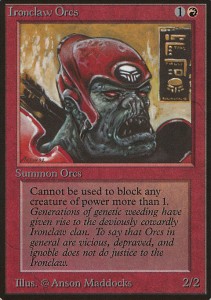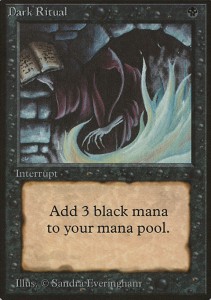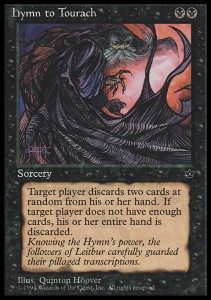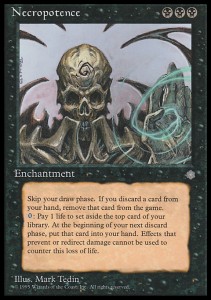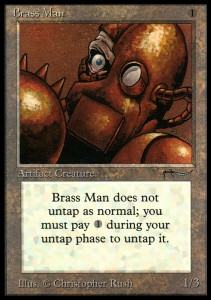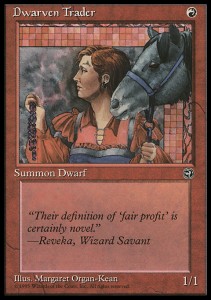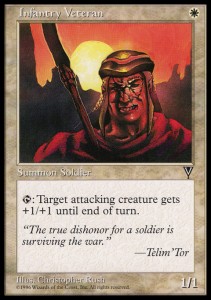Alternatively titled "Ironclaw Orcs Would Like a Word With You."
Allow me to introduce you two one of the most influential creatures in the history of Magic:
This creature and its friends revolutionized the way we think about Magic. Allow me to set the scene:
It's 1996. Tournament magic is in its infancy, but people are beginning to discover how awesome the game is. You are attending the nascent PTQ circuit in Atlanta, having just arrived in town recently. You are a good player, and you are armed with one of the best decks in the format. It plays cards like these:
There are other decks in the format too, but you really aren't worried much about them. Your deck is powerful, really powerful. You sit down for your first round, brimming with confidence. Your opponent wins the die roll, but that's okay. It's only the die roll after all. He then sits down, drops a Mountain, then drops this:
Brass Man? Who the hell plays Brass Man? You shrug, lay your Swamp and pass. Your opponent's next turn is the venerated Ironclaw Orcs, and a few turns later, you are dead. You are incredulous. "I'm playing Necropotence. How did I lose to such bad cards?"
Your opponent is smiling. Your second draw involves T1 Hypnotic Specter, usually a strong play. It gets Lightning Bolted. Well, at least he's playing that. That card is decent. Your opponent's next turn involves this venerated all-star:
Once again, a few turns later, you are dead. What's going on? How did you lose to such “bad” cards?
This is the story of one of the most influential decks of all time, designed by Jay Schneider. Here is the decklist:
[cardlist]
[Creatures]
2 Dwarven Trader
2 Goblin of the Flarg
4 Ironclaw Orcs
3 Dwarven Lieutenant
2 Orcish Librarian
2 Brothers of Fire
2 Orcish Artillery
2 Orcish Cannoneers
2 Dragon Whelp
[/Creatures]
[Spells]
4 Lightning Bolt
4 Incinerate
1 Fireball
1 Immolation
1 Shatter
1 Detonate
[/Spells]
[Artifacts]
4 Brass Man
1 Black Vise
[/Artifacts]
[Lands]
4 Strip Mine
4 Mishra's Factory
2 Dwarven Ruins
13 Mountain
[/Lands]
[/cardlist]
At the time, it was known as “Geeba,” today, you probably know it as “Sligh.” This was a format with all-stars like Necropotence, Dark Ritual, Hymn to Tourach, Armageddon, Wrath of God, and Land Tax, yet Jay Schneider and his group had the courage to sit down with Brass Man, Dwarven Trader, Goblins of the Flarg, and Orcish Librarian... and they won! In fact, they won a lot. How did this happen? Why did Goblins of the Flarg beat Necropotence?
Schneider, Sligh, and company won because they had developed the concept of the mana curve. Magic would never be the same after this realization. The idea of utilizing all your mana every turn fundamentally altered the landscape of the game as much as Weissman's idea of card advantage. Today, EVERY deck from mono-red aggro to UW control thinks about mana curve. Why is Mana Leak so crucial to UW? Because it is a counter that comes on curve.
So, what does this mean for M11 limited? If you like attacking for two, allow me to introduce you to your new best friend in the format:
When I saw the spoiler list, my eyes were immediately drawn to the white commons, with this card at the forefront, and visions of Geeba danced through my head. It was the second deck I thought of when looking at this set for limited (the first was Jace's Erasure.dec). I thought it would be strong, so when I opened Elite Vanguard at the prerelease, I decided to try drafting it. It was amazing, so I did it again. I came back prerelease weekend with a 5-2 record across three drafts with the deck, 3-0 with the best version I drafted. I was convinced. The deck is for real.
Sligh is built on three principles – mana curve, card advantage, and being able to progress an attack after the ground assault is stopped. The same principles can be applied to white-based aggro in M11 limited. Let's examine these principles one at a time. We'll start with, by far, the most important one – the mana curve.
Sligh's mana curve is as follows:
1 mana slot: 9-13
2 mana slot: 6-8
3 mana slot: 3-5
4 mana slot: 1-3
X spell: 2-3
Lightning bolt (critter kills): 8-10
mana 23-26 15-17 of color
Converting that to a 40-card curve:
1 mana slot: 6-8
2 mana slot: 4-5
3 mana slot: 2-3
4 mana slot: 2
X spell: 1-2
Lightning bolt (critter kills): 5-6
mana 16-17
Given that the only X-spell is Fireball we can safely ignore that spot on the curve. Let's take a look at the 1-4 slots.
1 drops
Common: Infantry Veteran
Uncommon: Elite Vanguard
2 drops
Common: Silvercoat Lion, Stormfront Pegasus, Squadron Hawk
Uncommon: Ajani's Pridemate, White Knight, War Priest of Thune
3 drops
Common: Wild Griffin
Uncommon: None
4 drops
Common: Assault Griffin, Cloud Crusader
Uncommon: None
From this it is clear to see that white provides very good options at 2 and 4, and some offerings at 1, but is clearly weak at 3.
Let's examine what other colors add:
Blue: Augury Owl, Aether Adept, Cloud Elemental, Azure Drake.
Black: Child of Night, Barony Vampire, Liliana's Specter, Howling Banshee, Nether Horror
Red: Goblin Balloon Brigade, Goblin Piker, Goblin Tunneler, Vulshok Berserker
Green: Llanowar Elves, Runeclaw Bear, Sacred Wolf, Cudgel Troll, Prized Unicorn
From this, it should be clear that blue and black are the best colors to pair with white, as they both supplement white with two playable three drops at common. There really isn't a way to supplement the underwhelming number of 1-drops (Llanowar Elves and Balloon Brigade are very weak), but that is less critical to limited than constructed, mainly because the format is slower, especially in core set formats like M11. In light of this fact, I would shoot for the following curve when drafting this deck:
1 mana slot: 3-4
2 mana slot: 5-7
3 mana slot: 4-5
4 mana slot: 2-3
This is exactly what made me feel the deck was viable. Having a mana curve is very powerful. M11 is the first core set ever, and maybe the set ever, where it is very plausible to draft a deck with a strong mana curve. For those of you who thought Zendikar decks had mana curves you are sadly mistaken. The one and three mana slots were terrible in that format, and decks relied on two drops and “evasion” to get the job done. Sure, the occasional deck showed up with a mana curve, but you couldn't rely on consistently getting it. Sure, Lacerator and Steppe Lynx were decent, but more often your “1-drops” were Adventuring Gear and Trusty Machete. M11, far more than Zendikar, truly showcases the power of the mana curve.
Now that we've established that the deck has a mana curve, can we apply Sligh's other principles to M11 limited? The second principle is card advantage. Sligh possessed actual card advantage engines like Orcish Librarian and Orcish Artillery. While we don't have those in M11 limited, we can generate virtual card advantage by applying pressure very quickly via tempo, since our creatures are much stronger than Sligh's were at that time. Our opponent's life total will dictate that draws like Platinum Angel are basically dead, since they won't be able to get to 7 mana to play her. Cards like Aether Adept are excellent in this manner also. Bouncing an early blocker to get through more damage can put your opponent in a tough situation.
So now we come to the third point – progressing the attack after our initial assault has been stopped. Here is where white excels in M11 limited. Please note that many of white's creatures fly, meaning that the initial assault is very difficult to stop in the first place. But what happens if your opponent manages to stunt your assault, what can you use to push through those last few points of damage? Enter the spells:
Important spells (in order of strength):
White: Armored Ascension, Mighty Leap, Inspired Charge, Pacifism, Excommunicate, Condemn
Blue: Mana Leak, Unsummon, Ice Cage, Mind Control
Black: Doom Blade
Red: Lightning Bolt, Fireball, Lava Axe, Thunder Strike, Volcanic Strength/Act of Treason, Shiv's Embrace
Green: Giant Growth
Once again, the spells show that White has the strong ability to push through bonus damage. Mighty Leap can send one of your ground guys to the air, allowing you more flying attackers to potentially make a profitable attack. It can also be used to pump an attacker to kill an annoying blocker, leaving you free to swing next turn. Inspired Charge will pump your entire team, and is particularly good in conjunction with a late Squadron Hawk (which goes to fetch its buddies). Armored Ascension creates a giant attacker, whereas Pacifism and Excommunicate are removal. Condemn is significantly weaker in this deck than most, mainly because it doesn't remove blockers.
Blue brings some “removal” but it also brings Mana Leak, which can stop problematic spells from ever hitting the table. Black brings arguably the most efficient removal spell to the table, whereas Red brings what it always brings to the party – burn. It also adds two reasonably strong enchantments and Act of Treason, which might be considered a burn spell. Green has the weakest offerings, simply providing the old standby of Giant Growth. I don't list Unholy Strength (it's playable, but I wouldn't be happy with it) because it doesn't pump toughness sufficiently to allow the creature to live through most blockers. +2/+1 is very different from +2/+2. The mountainwalk on Volcanic Strength is also very relevant. They're probably sideboard cards, but nothing to forget about.
As far as spells are concerned, it is better to pair white with red, as burn provides a very strong end-game while doubling as removal for problematic creatures. So, from a creature perspective, we want blue, but from a spells perspective, we want red. Black is, interestingly, in the middle. It provides a very good removal spell at common along with some very solid creatures. If you pick up an early Doom Blade or two, pairing white with black is also a legitimate option. Green just doesn't offer much, so you should not draft this deck as W/g. Three-color is also completely out, as stability is your biggest strength.
Your pick orders will vary greatly based on what you see, but it is important to note what color pairing you are in and what the weaknesses of the card pool are. You should pick one drops very high, while you can pass two-drops, because you are sure to get more. You should pick strong spells like Mighty Leap, Inspired Charge, Pacifism, Doom Blade, and Lightning Bolt very high because you are less likely to see them late than things like Silvercoat Lion.
Still, the most critical thing to remember while you are drafting is your mana curve. You want to have a consistent deck, and this is the most important part of drafting this archetype. You will beat many other decks that have more powerful cards long before they get to them, just because you will be able to apply consistent pressure. Remember, 1-4 are very important, and you probably are playing 1 five-drop at most. Nothing above that. That Vengeful Archon you opened pack 3? Pass it along.
As far as problems for the deck are concerned, some of them are obvious – Pyroclasm and Day of Judgment. Azure Drake and Cloud Elemental can also be annoying, giving you strong incentive to be blue (you get to pick cards that annoy you, and they are still playable in your deck). You will never play Pyroclasm, but it is definitely the best card in the set against you by a hundred miles and is well worth hating. You will lose games, even matches, to that card because the strategy relies so heavily on extending onto the board quickly, usually to the point of overextending. Pyroclasm punishes you for this like no other card in the set.
I urge you to try this archetype at your next draft, especially if you regularly see cards like Infantry Veteran and Mighty Leap go late. The archetype is reasonably easy to force because so many of the pieces are commons and also overlap in functionality. The only way you get kicked out of it is if you can't get white, which should become clear very early.
So, the next time you open up a pack of M11 in draft and see Elite Vanguard staring up at you perhaps it is time to ask yourself "What would Jay Schneider do?"
Chingsung Chang
Conelead on most forums
P.S. For those of you who are interested in reading about Sligh and the design principles behind the deck, there are good old article here and here.
















